 Does your dog become destructive, bark incessantly or otherwise misbehave when left alone? If so, it could be suffering from separation anxiety. Separation anxiety in dogs often manifests itself in rowdy behaviour such as barking, digging, destroying furniture or other household objects, which can be exhausting for you and your neighbours. Your dog may also become withdrawn and depressed. Any of these symptoms can indicate that your pooch is clearly not happy. Let’s learn more about the symptoms of separation anxiety in dogs, and how to prevent and treat it.
Does your dog become destructive, bark incessantly or otherwise misbehave when left alone? If so, it could be suffering from separation anxiety. Separation anxiety in dogs often manifests itself in rowdy behaviour such as barking, digging, destroying furniture or other household objects, which can be exhausting for you and your neighbours. Your dog may also become withdrawn and depressed. Any of these symptoms can indicate that your pooch is clearly not happy. Let’s learn more about the symptoms of separation anxiety in dogs, and how to prevent and treat it.Signs that your dog is suffering from separation anxiety
Many dogs suffering from separation anxiety become extremely destructive when their owners leave them at home alone, digging up the garden or shredding the couch, which can cause owners to pull their hair out in frustration. Some dogs become extremely vocal which can drive the neighbours crazy. Other symptoms of separation anxiety include messing in the house or trying to escape so they can follow their owner. In extreme cases dogs suffering from separation anxiety will lose their appetite, hide away in a corner, pant or whine excessively and generally look depressed when the owner is away, and will get extremely excited when their human returns home.
Diagnosing separation anxiety in dogs
As there are several different behavioural conditions that have similar symptoms to separation anxiety, it is essential that your vet (or trainer) not only assesses your pet’s symptoms, but also reviews his history to rule out a medical issue as the underlying cause of the behaviour. Puppies and kittens, for example, may not yet be fully house-trained or may be teething and their accidents or chewing may incorrectly be attributed to separation anxiety, when in fact it is not.
How to treat separation anxiety in dogs
Separation anxiety in dogs is primarily fear-based — your dog is afraid of being left alone without the companionship and security that you provide. You therefore need to reassure your pet that no harm will come to him when you are away, and that you will be back. You also need to ensure that he is kept entertained while you are away so that he doesn’t become bored and lonely.
In order to treat separation anxiety you will need to modify your dog’s behaviour and possibly also his environment to a certain extent. The following tips can help treat separation anxiety in dogs:
✓ Don’t make a big fuss as you prepare to leave the home, and again when you return. Rather try to keep your pet calm, calmly reassuring him you will be back soon. This may mean changing your routine slightly to prevent your pet from becoming overly stressed or excited.
✓ Make sure your dog has something to keep him occupied while you are away. Stimulating toys or tasty chews, for example, can alleviate boredom and stress. Provide a variety of toys, changing them daily to keep things interesting for your pet.
✓ If you only have one dog, consider getting him a friend for company. This is particularly important if you work all day and your dog is home alone for long periods of time. He is likely to become lonely and depressed if he has to spend most of his days home alone. Besides, animal shelters are bursting full of wonderful dogs that would love a home of their own!
✓ Other options include leaving your dog with a friend/relative, pet-sitter or doggie day care facility where it will have human and/or canine company rather than being all alone.
If the problem persists, you may need to seek professional advice from an experienced dog trainer or animal behaviourist. Discuss your pet’s separation anxiety issues with your vet, who may prescribe an anti-anxiety medication to help reduce your pet’s stress. If your vet prescribes medication for separation anxiety, the dosage can be reduced as your pet’s symptoms improve and discontinued once your pet becomes calmer and less anxious in your absence.